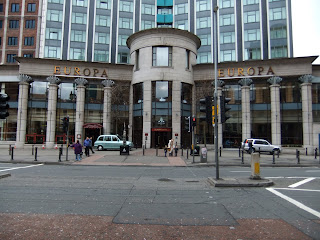







 My Great Great Great Grandfather, Bernard Jennings, was born in the Parish of Donaghmore, in the Townland of Derrycraw located in County Down, Province of Ulster. From what I can gather, he was born in 1792. I know that he was married in 1827 in Scotland to Catherine O'Rourke, and left Scotland in 1830 for Prince Edward Island, Canada. He died there in 1857.
My Great Great Great Grandfather, Bernard Jennings, was born in the Parish of Donaghmore, in the Townland of Derrycraw located in County Down, Province of Ulster. From what I can gather, he was born in 1792. I know that he was married in 1827 in Scotland to Catherine O'Rourke, and left Scotland in 1830 for Prince Edward Island, Canada. He died there in 1857. From A Topographical Dictionary of Ireland (1837) by Samuel Lewis
DONAGHMORE, a parish, in the barony of UPPER IVEAGH, county of DOWN, and province of ULSTER, 5 1/4 miles (N. by E.) from Newry; containing 4463 inhabitants. It is situated on the great road from Dublin to Belfast, and comprises, according to the Ordnance survey, 8396 1/4 statute acres; there are 110 acres of woodland, 499 of bog, 16 of waste, and 48 of water; the rest is arable and pasture land, generally good and in a high state of cultivation. Many of the inhabitants are employed in the weaving of linen for the merchants of Banbridge. Fairs are held on the first Friday in every month for cattle, sheep, and pigs, at Sheepbridge, which consists of only two houses, on the Newry road. Drummantine, the seat of the late Arthur Innis, Esq.; Beech Hill, of E. Curteis, Esq.; and the glebe-house, of the Rev. M. J. Mee, are the principal residences in the parish. The living is a vicarage, in the diocese of Dromore, and in the patronage of the Lord-Primate, to whom the rectory is appropriate: the tithes amount to £451, of which £251 is payable to the Lord-Primate, and £200 to the incumbent. The glebe-house, which is large and handsome, was erected in 1786, on a good glebe of 36 Irish acres, comprehending the townland of Tullagh, or Tullynacross. The church was built at the sole expense of Primate Boulter, in 1741 : it is a small handsome edifice in good repair, with a lofty tower ornamented with buttresses, pinnacles, and finials, which was erected, in 1828, by voluntary contributions. The R. C. parish is co-extensive with that of the Established Church: a handsome chapel is now being built at Barr, and there is a small one at Ballyblaw. A meeting-house for Presbyterians, in connection with the Synod of Ulster, stands on the borders of this parish and that of Newry; and at the Rock is a large meeting-house for Seceders. There is a parochial school on the glebe, built in 1818, and principally supported by the vicar, who gives the master one acre of land rent-free; also a school at Derrycraw, built and supported by Trevor Corry, Esq.; and there are five private schools. In the churchyard is a remarkable old cross; beneath it is the entrance to an artificial cave, which extends a considerable distance, the sides being formed of loose stones, covered over with large flat stones : near the centre is a cross or transept, forming two distinct chambers; the cave is about 3 feet wide, 5 feet high, and 62 feet long, and, at the cross, nearly 30 feet broad. The Dowagh, or Danes' Cast, passes through the western extremity of the parish, and in some places forms the boundary between it and Drumbanagher, and between the counties of Armagh and Down.














An Irish American Family moves from New York to Dublin, and creates Highlights in the place of their Roots.